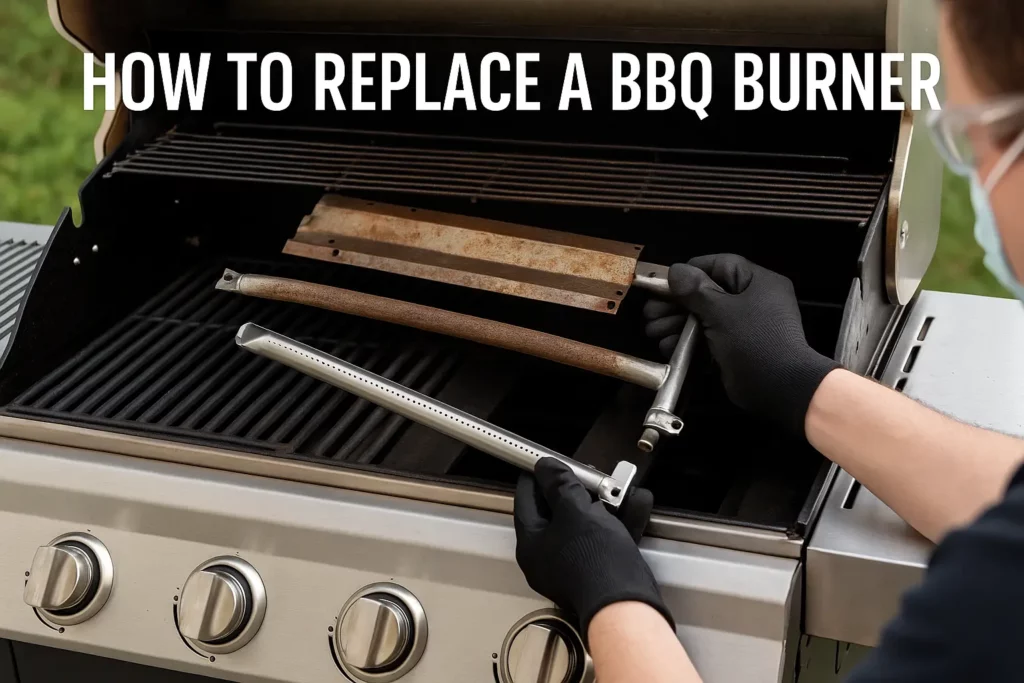This post may contain affiliate links. If you use these links to buy something we may earn a small commission. Thanks.
Grilling is one of the most satisfying ways to cook, especially during warm months when backyard barbecues become the highlight of weekends. But like any outdoor equipment, your BBQ grill experiences wear and tear over time. One of the most crucial parts that may eventually need replacing is the burner. If your grill is not heating evenly, taking too long to cook, or producing weak or inconsistent flames, it’s likely time to replace the burner.
In this comprehensive guide, we’ll walk you through everything you need to know about replacing a BBQ burner from safety precautions and selecting the right replacement part to step-by-step instructions and post-installation tips.
Why Replacing a BBQ Burner is Sometimes Necessary
Even the best burners don’t last forever. Whether you own a high-end stainless steel gas grill or a budget-friendly propane model, the burners will degrade over time due to:
- Constant exposure to high heat
- Moisture and humidity causing rust
- Clogs from food drippings and grease buildup
- Metal fatigue from expansion and contraction cycles
Common signs your burner needs replacing:
- Uneven flame or “cold spots” on the grill
- Yellow, flickering flames instead of steady blue ones
- Delayed ignition or no ignition at all
- Visible rust holes or cracks in the burner tube
- Excessive flare-ups or popping noises
If your grill exhibits any of these symptoms, don’t ignore them replacing the burner will not only restore your grill’s performance but also keep it safe to use.

Safety First: Preparing for the Replacement
Before diving into the mechanical steps, your safety must come first. Replacing a BBQ burner involves working with gas lines and metal parts, so caution is key.
Turn Off the Gas
- If you’re using a propane grill, ensure the tank valve is turned off completely.
- For natural gas grills, shut off the gas supply from the main valve.
Disconnect the Gas Source
- If the gas line is removable, disconnect it for added safety.
- Make sure the grill has completely cooled down from previous use.
Prepare Your Workspace
- Set your tools nearby: screwdriver, wrench, gloves, a wire brush, and a flashlight.
- Wear protective gloves and safety glasses.
- Place a drop cloth under the grill to catch screws or debris.
Identify the Type of Burner You Need
Not all burners are created equal. Gas grills come in different shapes and sizes, and so do their burner types. Knowing the exact burner you need is essential to avoid purchasing the wrong part.
Find Your Grill’s Model Number
- Check for a label inside the grill’s cabinet or on the back panel.
- Consult the user manual if you have it.
Understand Burner Types
- Straight tube burners – Common in rectangular grills
- H-shaped burners – Two parallel tubes with a connecting tube
- U-shaped burners – Found in some compact or specialty grills
- Oval burners – Used in older or unique grill models
- Infrared burners – Specialized components used in high-end models
Sourcing the Replacement
- Visit the manufacturer’s website or a third-party BBQ parts supplier.
- Use your grill’s model number to ensure compatibility.
- Look for stainless steel or brass burners for longer durability.
Access the Burner Area
Once you’ve secured your new burner and prepped your workspace, it’s time to start dismantling your grill.
Step-by-Step:
- Lift the Grill Hood – Make sure it stays open and stable.
- Remove the Cooking Grates – Lift them out and set aside.
- Take Out the Flame Tamers or Heat Tents – These sit above the burners and protect them from drippings.
- Locate the Burner Mounts – Most burners are secured with a screw, cotter pin, or clip.
- Inspect Igniter Wires and Crossover Tubes – If your burner connects to igniters or crossover tubes, note how they’re attached for reassembly.
Use your phone to snap a few pictures this will help during reinstallation.
Remove the Old Burner
Now comes the moment of removing the worn-out burner. Take your time with this step to avoid damaging adjacent parts.
How to Remove:
- Unscrew the Mounting Screws – Use a screwdriver or wrench depending on the fasteners used.
- Detach Igniter Wires Carefully – Do not yank; gently wiggle them off if connected.
- Lift and Slide – Some burners slide off gas valves while others lift vertically—consult your manual if unsure.
- Check for Rust or Debris – If the burner is stuck, use a little penetrating oil and gently tap with a rubber mallet.
Once removed, inspect the inside of the burner area. Clean out any rust, char, or debris with a wire brush or shop vacuum.
Install the New Burner
Installing the new burner is generally easier than removing the old one, especially if you took pictures or labeled any wires or parts.
Steps to Install:
- Compare New and Old Burners – Ensure ports, size, and mounts match.
- Slide or Set in Place – Align the new burner to the gas valve nozzle.
- Reconnect Igniters or Crossover Tubes – Make sure these are securely fastened and in proper alignment.
- Secure with Screws or Clips – Don’t overtighten—just enough to hold it firm.
- Double-Check Burner Alignment – Burner ports should face upward and be evenly spaced from the flame tamers.
If your grill has adjustable air shutters on the burner, position them to allow for fine-tuning the flame later.
Reassemble the Grill
Once your new burner is locked in and ready, it’s time to put your BBQ back together.
Reassembly Checklist:
- Reattach flame tamers or heat shields over the burner
- Replace the grill grates
- Reconnect any wires or clips that were removed
- Reconnect the gas line if it was disconnected
Before testing, it’s a good idea to inspect the area for gas leaks.
Pro Tip: Soapy Water Leak Test
- Mix water with a few drops of dish soap
- Apply it around the gas connections
- Turn on the gas (without igniting)
- Look for bubbles—if any form, tighten the connection or replace the fitting
Test the New Burner
Now the moment of truth—let’s see how well the new burner performs.
Testing Steps:
- Turn On the Gas – Slowly open the valve to allow a steady flow.
- Ignite the Grill – Use the electronic igniter or a lighter stick.
- Observe the Flame – You’re looking for:
- Steady blue flame with light yellow tips
- No sputtering or flickering
- Even heat across the burner length
If the flame is too yellow or weak, adjust the air shutter (if available) to control the air-to-gas ratio.
Let the burner run for 5–10 minutes to ensure stable performance before cooking.
Maintenance Tips to Extend Burner Life
Burners don’t have to be replaced frequently if you care for them properly. With a few maintenance habits, you can easily double the lifespan of your BBQ burner.
Regular Cleaning
- Use a wire brush to scrub off food particles after each grilling session
- Clean burner ports using a toothpick or small drill bit (gently)
- Empty grease trays regularly to prevent flare-ups
Seasonal Maintenance
- Inspect for cracks, corrosion, or clogs every spring and fall
- Store your grill in a covered area or use a weatherproof cover
- Apply light oil to metal burners to prevent rust in the off-season
Avoid Common Mistakes
- Don’t use harsh chemical cleaners directly on burners
- Don’t operate the grill with blocked burner ports
- Don’t ignore weak flame or poor heat performance—it’s often a sign something’s wrong
Conclusion
Replacing a BBQ burner may sound like a job for a professional, but it’s well within reach for most DIYers. Whether your burner has rusted through or is simply not firing like it used to, replacing it can dramatically improve your grill’s performance—and extend its usable life by years.
By following this step-by-step guide, you’ll:
- Restore strong and even heat
- Improve fuel efficiency
- Make your grill safer to use
A high-performing burner means better grilling results—juicier steaks, crispier veggies, and faster cook times. So if your BBQ is showing signs of burnout, don’t wait. A simple burner replacement might be all it takes to bring your backyard grilling game back to life.
FAQs
Q1: How long does a BBQ burner typically last?
A: Most burners last 2–5 years depending on the material and how often you grill. Stainless steel burners tend to last longer than regular steel.
Q2: Can I replace the burner with a different style or brand?
A: It’s best to stick with OEM or compatible parts that match your grill’s design. Modifying burners can affect performance and void your warranty.
Q3: What’s the cost of a replacement burner?
A: Replacement burners typically cost between $15 and $70, depending on the type, size, and material.
